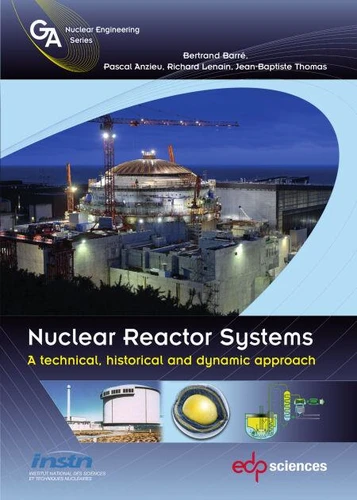Nuclear Reactor Systems. A Technical, Historical and Dynamic Approach
Par : , , ,Formats :
Disponible dans votre compte client Decitre ou Furet du Nord dès validation de votre commande. Le format PDF est :
- Compatible avec une lecture sur My Vivlio (smartphone, tablette, ordinateur)
- Compatible avec une lecture sur liseuses Vivlio
- Pour les liseuses autres que Vivlio, vous devez utiliser le logiciel Adobe Digital Edition. Non compatible avec la lecture sur les liseuses Kindle, Remarkable et Sony
 , qui est-ce ?
, qui est-ce ?Notre partenaire de plateforme de lecture numérique où vous retrouverez l'ensemble de vos ebooks gratuitement
Pour en savoir plus sur nos ebooks, consultez notre aide en ligne ici
- Nombre de pages432
- FormatPDF
- ISBN978-2-7598-1985-0
- EAN9782759819850
- Date de parution03/03/2016
- Protection num.Digital Watermarking
- Taille79 Mo
- Infos supplémentairespdf
- ÉditeurEDP Sciences
Résumé
The evolution of nuclear reactors since the 1942 Fermi experiment can be described along the lines of natural history, with an initial - flourish of uninhibited creativity followed by a severe selection process leading to a handful of surviving species, with light water reactors occupying most of
the biotope today.
This book combines four approaches:
. A descriptive one. is gives an overview of the main strengths and weaknesses of the di erent reactor systems.
.
A historical approach, from the 1940's to nowadays, with an extrapolation to the near future. The LWR dominance being rmly established, what is the next step? . An axiomatic approach. Starting with a set of long term criteria concerning the fuel cycle sustainability, a conceptual solution is established, and then a family of reactor systems is selected for development and qualification. . A dynamic approach.
In the early 2000s, the prevailing image combined a "nuclear renaissance", a strong limitation of the greenhouse gases concentration and a dynamic growth of the world economy. Updating the strategy in the wake of the last decade events requires a sharper understanding of the driving forces as well as of the influence of the post-Fukushima safety framework on the design constraints.
A historical approach, from the 1940's to nowadays, with an extrapolation to the near future. The LWR dominance being rmly established, what is the next step? . An axiomatic approach. Starting with a set of long term criteria concerning the fuel cycle sustainability, a conceptual solution is established, and then a family of reactor systems is selected for development and qualification. . A dynamic approach.
In the early 2000s, the prevailing image combined a "nuclear renaissance", a strong limitation of the greenhouse gases concentration and a dynamic growth of the world economy. Updating the strategy in the wake of the last decade events requires a sharper understanding of the driving forces as well as of the influence of the post-Fukushima safety framework on the design constraints.
The evolution of nuclear reactors since the 1942 Fermi experiment can be described along the lines of natural history, with an initial - flourish of uninhibited creativity followed by a severe selection process leading to a handful of surviving species, with light water reactors occupying most of
the biotope today.
This book combines four approaches:
. A descriptive one. is gives an overview of the main strengths and weaknesses of the di erent reactor systems.
.
A historical approach, from the 1940's to nowadays, with an extrapolation to the near future. The LWR dominance being rmly established, what is the next step? . An axiomatic approach. Starting with a set of long term criteria concerning the fuel cycle sustainability, a conceptual solution is established, and then a family of reactor systems is selected for development and qualification. . A dynamic approach.
In the early 2000s, the prevailing image combined a "nuclear renaissance", a strong limitation of the greenhouse gases concentration and a dynamic growth of the world economy. Updating the strategy in the wake of the last decade events requires a sharper understanding of the driving forces as well as of the influence of the post-Fukushima safety framework on the design constraints.
A historical approach, from the 1940's to nowadays, with an extrapolation to the near future. The LWR dominance being rmly established, what is the next step? . An axiomatic approach. Starting with a set of long term criteria concerning the fuel cycle sustainability, a conceptual solution is established, and then a family of reactor systems is selected for development and qualification. . A dynamic approach.
In the early 2000s, the prevailing image combined a "nuclear renaissance", a strong limitation of the greenhouse gases concentration and a dynamic growth of the world economy. Updating the strategy in the wake of the last decade events requires a sharper understanding of the driving forces as well as of the influence of the post-Fukushima safety framework on the design constraints.





